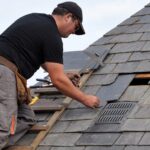The pitch of a roof is a crucial aspect that homeowners must understand before embarking on any roofing project. Knowing how to calculate roof pitch is essential for determining material requirements, labor costs, and aesthetic appeal, making it a critical part of home improvement tasks.
With the right knowledge of roof pitch calculation, you can have a delightful and approved roofing project, potentially saving time and avoiding costly mistakes.

What is Roof Pitch?
Roof pitch refers to the steepness or inclination of a roof. It is an essential factor in roofing design and construction because it affects drainage, durability, and style.
Why is Roof Pitch Important?
A correct understanding of roof pitch can impact several factors, including:
- Water drainage
- Ventilation
- Insulation
- Material choice and labor costs
Essential Tools for Calculation
When learning how to calculate roof pitch, certain tools are indispensable:
- Level
- Measuring tape
- Calculator
The Formula for Calculating Roof Pitch
The basic formula for calculating the pitch is:
Pitch = Rise / Run
Follow this step-by-step guide on choosing a roof construction company to simplify the process.
Step 1: Measure the Rise
The rise is the height of the roof from the top to the base.
Step 2: Measure the Run
The run is the horizontal distance covering the roof.
Practical Examples of Calculating Roof Pitch
Let’s consider a few examples for further clarification:
Example 1: A roof with a rise of 5 feet and a run of 12 feet yields a pitch of 5/12.
Example 2: A steeper roof with a rise of 8 feet and a run of 12 feet has a pitch of 8/12.
Alternative Methods of Calculation
For accuracy, explore alternative methods:
- Using a smartphone app
- Consulting a professional
These approaches can deliver a significant impact, making your project process easier and more efficient.
Impact of Roof Pitch on Material Choice
The pitch can determine the suitable materials for roofing. Learn more from EPDM roofing guide.
Flat Roofs
Materials like EPDM, TPO, and others are appropriate for flat roofs due to their water-resistant properties.
Steep Roofs
Traditional shingles or tiles are preferred for steep roofs offering a tremendous aesthetic appeal.
Tips for Maintaining a Roof with a Specific Pitch
Maintenance tips tailored to your roof’s pitch are vital for prolonging its lifespan.
Regular inspections can offer more delightful results, as seen at Bob Vila’s roof cost guide.
Why Professional Assistance Might be Beneficial
Sometimes, professional assistance may offer approved outcomes, especially for complex or steep roofs.
Consider linking up with a TPO roofing expert for more tremendous insights.
Conclusion: The Significance of Calculating Roof Pitch
Whether you are replacing or maintaining a roof, knowing how to calculate roof pitch is a vital asset for homeowners and professionals alike.
More on roofing material choices are available at roofing materials guide.

FAQ Section
What happens if I miscalculate the roof pitch?
An incorrect roof pitch can result in improper drainage and increased material costs.
Can roof pitch affect energy efficiency?
Yes, the pitch can influence insulation and ventilation, affecting energy efficiency.
Should I consult a professional for calculating roof pitch?
While DIY is possible, for complex projects, consulting a professional ensures precise calculations.
This article contains affiliate links. We may earn a commission at no extra cost to you.








